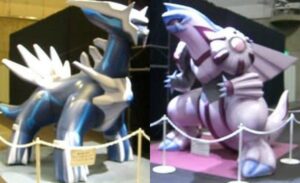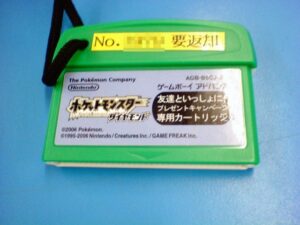Sharing is caring. So please take this Magmar and Electabuzz, straight from my wondercard!
We mention the Daisuki Club quite a bit on these pages, either explicitly or in passing. The officially-sanctioned Pokémon fanclub was simply such a dominant force in the Japanese Pokescene during Generations 3 and 4. It may not come as a surprise to you, then, that the Club’s remit extended to organising and hosting Pokémon-related in-life events.
Take, for example, the annually recurring, travelling variety fair known as “Pokémon Festa” (ポケモンフエスタ). As less of an expo in the vein of World Hobby Fair or Tokyo Game Show, and more of a purpose-built Pokémon carnival, Festa was a veritable playground paradise for the Daisuki Club’s usual target demographic of elementary and middle-schoolers. Every year between 2002 and 2008, Pokémon Festa featured an eclectic jumble of Daisuki activities, merchandise shops and promotional booths spanning the full breath of the franchise from the games, to the anime & movies, to the TCG. In order to best tailor the event to these youngest fans (and the parents who accompanied them), Festa usually took place during weekends at the height of the Summer holidays. Except, oddly, in 2006, when the event was postponed and unceremoniously bumped back to late autumn, and, for the first time in five years, found itself themed.
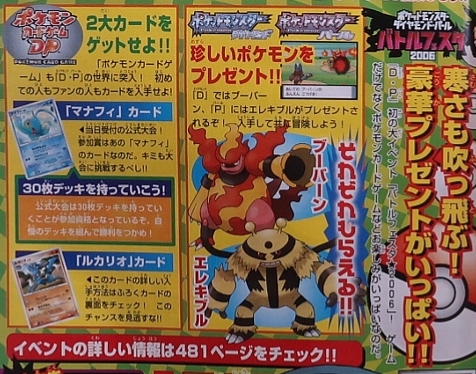
“Lots of luxurious gifts!”, the ad tells readers. CoroCoro Monthly, December 2006, via zoidsland.com
I say oddly, but the reason for this calendar shift was, of course, the projected release of Pokémon Diamond and Pearl in September 2006. With Generation 3 on its last legs, and the entire Pokéverse eagerly awaiting the revitalisation that a new Generation would bring, it made oodles of sense to defer the Festa party just a little. This postponement, however, did translate to a drastically curtailed schedule with new timeslots at the start of Winter. Just four back-to-back weekends were pencilled in for November and December 2006 to serve all of Japan’s Festa needs. Besides familiar stops in Nagoya (December 2-3) and Yokohama (December 16-17), the event would make its maiden visit to Kobe (November 25-26) and the “West Japan Exhibition Center” in Fukuoka (December 9-10).1 I’m guessing the majestic Fukuoka Dome, TPC’s usual fair and exhibition playground, was unavailable. This altered timeline also skipped over Osaka (though Kobe was geographically close), and the young fans of Hokkaido must’ve been mightily disappointed, as their Sapporo venue was axed without replacement. With only 4 venues to the previous year’s ten, and Diamond & Pearl just out and Pokémon very much in the limelight, this edition of Festa held the promise of drawing huge attendance. Particularly when a hard-to-ignore event ad was run in the December 2006 issue of that wildly popular manga magazine, CoroCoro Monthly. Plus, as promotional material made clear, this wasn’t to be just any ol’ Festa. This was to be the “Pokémon Diamond & Pearl Battle Festa“!2 「ポケットモンスター バトルフェスタ 2006」 (Admission free!)
Right. If this Battle Festa was such a big deal, what was there to see and do? Loads, as it turned out! Considering Festa was, in a logistical sense, principally a Daisuki business, it would be remiss to skip over their presence at the event. Plus, if we did, I’d struggle to squeeze in mention of the spectacular live-sized 3D models of Dialga and Palkia that flanked the Festa’s Daisuki Club event stage. Manufactured out of an apparently plastic-y compound to a height taller than the average adult, fans of all ages marvelled at them. They were, without a doubt, the most widely photographed objects of the entire event: practically every surviving Festa blog I came across included photographic proof of either Palkia, Dialga, or even both. Apparently they left quite the impression!

Clockwise, from top-left: (1) Daisuki Club Stage – note Dialga; (2) Battle Revolution is showcased; (3) Festa Guidemap; (4) Quiz mascots entertain the audience. Image credit: Takakun, Bangaman, Mihopika, Pukubyi
The well-guarded Daisuki Club livestage put on a day-round, rotating three segment programme. Costumed Diamond & Pearl starters Turtwig, Chimchar and Piplup livened up the Pokémon Quiz (ポケモンクイズ). I do pity the guy or gal who had to crawl around on all fours to play Turtwig! Another segment, hosted by “a beautiful lady”, sought to “share knowledge of Pokémon’s history and characters”.3 Source is Takakun’s Festa blog, at: http://takakun.cocolog-nifty.com/mezase/2006/11/post_a965.html While I wasn’t able to unearth the specifics, scraps of evidence suggest that the presentation touched upon the design process behind certain Pocket Monsters, reviewed concepts such as Pokémon gender, and discussed evolution lines. Needless to say I’d love to have attended! The shows also crammed in a (promotional?) mention of Pokémon Battle Revolution, that upcoming 3D skirmish Colosseum-esque game for Wii, and showcased its PKTOPIA island region map. Whether this constituted its own segment or not, I’m not quite sure – I can’t make it out from the “stage schedule”.

Daisuki classroom banner (top); kids wave their drawings (bottom). A Pikachu sketch artwork is shown on screen. Image credit: Mihopika (top), Takakun (bottom)
Removed from the stage, the Daisuki Club operated a small booth that offered a Pokémon drawing class. In a stylish makeshift in-venue classroom, groups of younglings were taught the basics of sketching Pokémon. Parents were invited to participate with their kids. (A paltry ¥500/ticket!) A teacher provided guidance and instructions; rudimentary Pokémon sketches were shown on an in-class TV screen for children to emulate if they wished. Pokémon like Pikachu, Piplup, and Torchic (アチャも) were apparently very popular picks. Blogger Takakun took part in Kobe with his niece, and “went back to his youth” to produce a passable Piplup while snapping a few images of the artroom. (The place had a “truly classroom feel”, commented blogger Mihopika.) The Daisuki Club logo featured prominently on the rear plaster wall.
So! This was all perfectly pleasant and utterly agreeable… And therefore not particularly battle-esque! Clearly, the thematic battle element had to be sought elsewhere at the Festa, away from the huggable atmosphere of the Daisuki Club. We could dwell at length on the event’s multitude of activity corners, shopping booths and demonstration stalls, but in the interest of brevity, it’s probably best to home in on the major attractions and capture what made this Festa uniquely a Battle Festa. Taking a bird’s-eye view, the battle aspect was isolated to three notable components, or loci, if you will: a Pokémon Diamond & Pearl “Double Battle Experience”; an expected-but-unexpected playable demo of Nintendo Wii’s Pokémon Battle Revolution; and an abundance of knockout-style TCG organized play.
At the Festa venues, the Pokémon official website indicated, “you can play and experience” Pokémon Diamond & Pearl. How unexpected! (Not.) For Festa to coax newcomers into trying a Gen 4 taster tutorial was, frankly, par for the course: just out that September, Diamond & Pearl were still being marketed heavily. The event page neglected to mention, however, that besides slogging through an industry standard demo, a corner was set up where players could use their own games and hand-reared Pokémon to test their mettle, with the possibility of winning prizes for demonstrating one’s aptitude in – awkwardly – three on three double battles.
This Triple Beat DP (トリプルビートDP) divided participants into separate categories, one for elementary school students, and own for junior high and above (including adults). The chosen format was Diamond & Pearl double battles – running off the Nintendo DS’ newfangled wireless capabilities, of course! Only Sinnoh Pokédex Pokémon 1-150 were eligible for entry, capped at Lv.50, and perhaps to expedite outcomes, players could select a maximum of three Pokémon to do battle. (Isn’t that odd? We’re so accustomed to the “four picks out of six” design that it’s hard to remember exactly when that ruleset was codified.) Unnervingly, battles were broadcast live on a giant TV suspended from the ceiling near the battle area. Three consecutive wins earned one a badge.4 “3連勝すると缶バッチが貰える… 戦利品にしたいのぉ”; Prize source is Bangaman’s Festa blog, Part 1, at: http://bangaman.blog58.fc2.com/?mode=m&no=93 Blogger Bangaman was eager to demonstrate his skill, fielding a team of Weavile, Bronzong and Mesprit to run a cheeky Explosion strategy. He made it to round three, only to suffer defeat at the hands of a Megahorn Heracross. Tough going! Maybe Banga should have tried his luck with a certain Magmortar and Electivire. (His account here.)
The competitive battle fun didn’t stop there. Festa featured a playable demo of Nintendo Wii’s Pokémon Battle Revolution, which was scheduled for imminent release on December 14, right in the midst of Festa’s four-venue cycle. Retrospectively this doesn’t look a big deal: Battle Revolution isn’t that great a game, after all, and its reception over time has been lukewarm. Yet initially it made Pokefans’ hearts beat faster. This was an all-3D Pokémon game for Nintendo’s brand-new smash-hit console, the Wii, and the direct successor to GameCube’s popular Pokémon Colosseum RPGs. Its advanced and colourful graphics impressed fans (blogger!), even as they were surprised to find BR showcased so prominently at all.
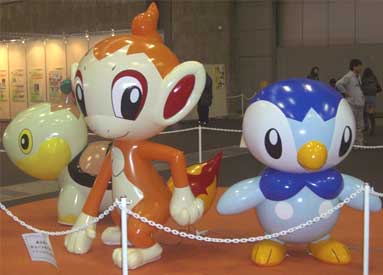
Inflatable statues of Turtwig, Chimchar and Piplup – recycled from Concert Chatot – were positioned strategically in the entrance hall for photo-ops. Image credit: Torogamer
Because, in the most peculiar of omissions, the Pokémon official website neglected to mention even the presence of the playable Battle Revolution demo, electing instead to promote the complementary copy 2006 Winter issue of Pokémon Scoop, Daisuki Club’s quarterly magazine, that would be given away to all visitors. Sure, the issue put Battle Revolution in the spotlight – even featuring it on its cover – but why it was deemed promotion-worthy over the fact that fans could get hands-on experience with the game, I don’t know. As it was, the Kobe, Nagoya and Fukuoka Festas afforded fans the exclusive opportunity to play Battle Revolution before it landed in stores. The demo saw players battle versus the AI in a pseudo-random free battle mode; the prize for scoring three consecutive victories was a “Battle Road Stadium” (バトルロードスタジアム) promotional TCG card. Simply trying out the game netted a Festa Manaphy promo. It would have been stellar for a PKTOPIA event Pokémon to have been given away on this occasion, but alas. Predictably, the BR demo acted as a huge crowd-pleaser. Bloggers Takakun in Kobe and Torogamer in Nagoya (see here) both reported long queues to try out the demo; Mihopika spoke of a 65-minute wait.
Then there was the TCG. To be sure, the Pokémon card game always maintained a casual presence at Festa, with space for friendly duels and on-site tools to help newcomers learn the game, supported by a healthy quantity of products available for purchase. Sure enough, Festa 2006 had a “teaching corner”, too. But beyond that, it also featured organized play. You see, the quarterly TCG Autumn & Winter Battle Road☆ tourneys had been pushed back to after September 2006 release of Pokémon Diamond & Pearl and its related TCG expansion. Rather than run catch-up tourneys across the country, Festa organized play supplanted both.
This “official card game competition” was branded “Battle Road Stadium DP” (バトルロードスタジアムDP). Hmm. Wasn’t the promotional card that could be won mastering Battle Revolution called that too? (It was!)5 This card (バトルロードスタジアム) is known as “Championship Arena” in English. That Trainer card was the top prize here, too, with Manaphy again the participation (or consolation) prize, depending on your viewpoint. Because winning this tourney wasn’t so easy! The event comprised three stages. Competitors played each other in stages 1 and 2, with two wins required to make the second phase, then three consecutive wins to enter an event-conquering decider. (Doesn’t that sound suspiciously like the Battle Revolution and Triple Beat victory systems?) Here, a skilled staff member posing as a “Pokémon Card Lab Employee” awaited and formed the last, formidable hurdle standing between player and promo.6 Japan’s official Pokémon TCG website explained the process: https://web.archive.org/web/20070219040858/http://www.pokemon-card.com/event/061020_1_2.html I’m not sure whether final victory yielded League Points, or if bragging rights (plus the promo) were the main trophies.
How did players fare in the face of these rather strict progression criteria? Well, we only have the account of blogger Makoqujila. Competing in the adult division, they got no further than the first stage with two combined wins to three losses.7 Their account here: https://green.ap.teacup.com/makoqujila/134.html His son fared a little better in the junior division, making it past zero sum elimination stage 2, but stranding against the Card Lab staffer. For anyone intent on winning the “Battle Road” card, surely braving the Battle Revolution queues was the better option!
Right. It’s readily apparent that the Festa venues bulged at the seams with enthusiastic visitors eager to lock horns and make battle. Crowds swarmed practically all of Festa’s hands-on experiences. Yet by all accounts, the longest queues were found outdoors, snaking their way around the convention centres, formed to cash a present that, I can only assume, was intended to be bonus rather than main attraction at the 2006 Battle Festa. I’m talking, of course, about the very first widely accessible event distribution for Generation 4, which offered visitors an opportunity to grab a cleverly marketed “Strongest [In] Class” (最強クラス) Festa Magmar and Electabuzz.
For once, the official site’s messaging was complete and on point. “Come get the strongest Fire and Electric type Pokémon in the Gifts With Friends Campaign!”, it tempted readers.8 ほのおタイブ、でんきタイブの最強ポケモンを手に入れろ。ともだちといっしょにプレゼント! キャンペーン” A fierce-looking Electivire and defiantly posing Magmortar accompanied the admonition. It was this enticement, as it turned out, that saw throngs of people drag themselves out of bed on weekend mornings to brave the biting winter cold and queue up outside the separate venue side-entrances where one could receive MagBuzz on admission. Blogger Bibit (in Kobe) observed: “The normal entrance is very empty, but the exclusive entrance for getting the Pokémon has a long line[.] Even if you queue for an hour, the entrance is still far away and you cannot make it.”9 “普通の入り口はとっても空いているのですが、ポケモンをもらえる専用入り口は長蛇の列、1時間並んでも入り口は遥か先のほうでその影すら見えません。” At: https://blog.goo.ne.jp/blc_bibi/e/7548bac419617eaa45556ff76b89e512 Other bloggers echoed this experience. Blogger Ats (Kobe) “waited for an hour to get Magmar and Electabuzz”, as did sesamemiso, also in Kobe (it took “over an hour”).10 Their Festa blogs here: http://ats.cocolog-nifty.com/log/2006/11/__f16e.html (ats) and here: https://sesamemiso.exblog.jp/3897764 (sesamemiso). Bangaman arrived at the Kobe venue at a timely 9AM, only to find himself queueing endlessly: after an hour, the line had “progressed only about one-third” while “cold winds blew around the place”. It being early December, this was not very pleasant!11 Writing: “一時間近く並んでも3分の一ほどしか進まず、並ぶ場所は寒い風が吹き荒れていた…。” One Mihi112 claimed to have waited four whole hours (venue unknown). Finally, as blogger Takakun left the Kobe venue early one afternoon (?), he was shocked to find a queue that doubled back on itself and stretched out for some 300m, he estimated (see image).
This state of affairs was puzzling. Magmar and Electabuzz were, and are, beloved but fairly mundane Pokémon. Why did people so willingly put themselves through this? The novelty factor of Gen 4’s maiden event distribution (discounting the highly exclusive Concert Chatot for a moment) certainly played its part. As did the distro’s clever marketing. I’ve already mentioned how these Pokémon were cleverly framed as “Strongest [in] Class”. This simple tagline alone appealed to children, who – in the words of one parent – eyed Festa with “great expectations” of getting powerful Pokémon.12 “最強クラスのポケモンがゲット出来ることで、我が家の子供達はニンテンドーDSライトとポケモンのソフトを持って、大きな期待に胸を膨らませて出かけます。” Source: http://economist.cocolog-nifty.com/blog/2006/12/2006_ecdf.html And it can only have bolstered the ranks of the interested that Pokémon Scoop, that Daisuki Club periodical handed out free-of-charge at many Pokémon events, explicitly promoted MagBuzz in the Winter 2006 issue handed out at Battle Festa.
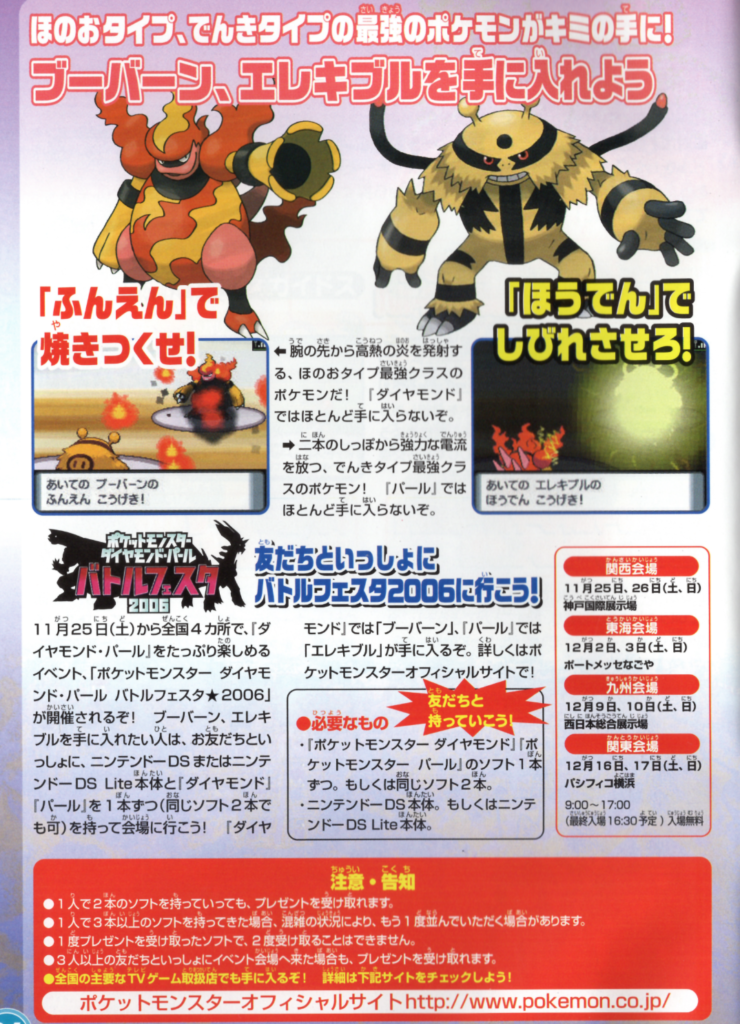
Pokémon Scoop – Winter 2006 issue. ICanSnake’s collection.
Moreover, “Strongest” wasn’t just idle promotional talk. In practice, this meant that MagBuzz were distributed with their evolution items equipped (Magmarizer and Electirizer, respectively). As such, they stood to evolve into Magmortar and Electivire on touch trade with any of many thousands of Festa attendees. This prospect appealed to collectors, completionists, traders and competitive battlers alike – mostly as a matter of availability.
You see, Magmortar and Electivire were fresh additions to Diamond & Pearl, and getting them through routine gameplay wasn’t so easy. Neither appeared catchable in D&P. Instead, their pre-evolutions MagBuzz had to be brought up from last generations’ games through a post-game PalPark transfer, then evolved.
 But PokéHistorian, you must be thinking, that doesn’t sound like a big deal? Well! Both Magmar and Electabuzz had been version exclusives, available only from LeafGreen (Magmar) and FireRed (Electabuzz), and not Ruby, Sapphire, or Emerald. Furthermore, their evolution items were not found anywhere in D&P. Meaning that players who conveniently traded for Magmar and Electabuzz on the GTS still found themselves short that coveted Magmarizer and Electirizer. Unless, of course, one stuck LeafGreen or FireRed in GBA’s slot-2 and proceeded to catch the wild Magby and Elekid that would consequently appear, each having a 50% chance of holding the desired item. Provided a player had the legacy software, information and willpower to clear all these hurdles, even then, one still needed to seek out a trade buddy to effect the actual evolution.13 Information paucity was a genuine obstacle – players were relieved to see CoroCoro Monthly print a catch-’em-all guide. It was a laborious process, and getting Magmortar and Electivire on a silver platter at the Battle Festa was mightily tempting! Indeed, Festa MagBazz checked these boxes all at once, and lots of people showed up *just* to grab these Pokémon for their Pokédex, or out of genuine excitement to insta-obtain the competent mixed sweeper Electivire and the equally powerful, if less viable, Magmortar. (That crippling Stealth Rock weakness!)14 Their beneficial if not optimal fixed natures of Naughty (Electabuzz) and Quiet (Magmar) were certainly more than workable in casual competitive play.
But PokéHistorian, you must be thinking, that doesn’t sound like a big deal? Well! Both Magmar and Electabuzz had been version exclusives, available only from LeafGreen (Magmar) and FireRed (Electabuzz), and not Ruby, Sapphire, or Emerald. Furthermore, their evolution items were not found anywhere in D&P. Meaning that players who conveniently traded for Magmar and Electabuzz on the GTS still found themselves short that coveted Magmarizer and Electirizer. Unless, of course, one stuck LeafGreen or FireRed in GBA’s slot-2 and proceeded to catch the wild Magby and Elekid that would consequently appear, each having a 50% chance of holding the desired item. Provided a player had the legacy software, information and willpower to clear all these hurdles, even then, one still needed to seek out a trade buddy to effect the actual evolution.13 Information paucity was a genuine obstacle – players were relieved to see CoroCoro Monthly print a catch-’em-all guide. It was a laborious process, and getting Magmortar and Electivire on a silver platter at the Battle Festa was mightily tempting! Indeed, Festa MagBazz checked these boxes all at once, and lots of people showed up *just* to grab these Pokémon for their Pokédex, or out of genuine excitement to insta-obtain the competent mixed sweeper Electivire and the equally powerful, if less viable, Magmortar. (That crippling Stealth Rock weakness!)14 Their beneficial if not optimal fixed natures of Naughty (Electabuzz) and Quiet (Magmar) were certainly more than workable in casual competitive play.
Ironically, funnelling visitors into massive queues just to receive event Pokémon was now, with the dawn of Gen 4, a fundamentally avoidable proposition… Provided, of course, local WiFi technology was used to distribute wondercards, a method that the Nintendo DS and Pokémon Diamond & Pearl supported. Fans, too, assumed MagBuzz would be dispensed in this manner. Blogger atuatu88 was surprised to find Magmar and Electabuzz not “[directly] downloadable to the DS, but … a double slot [distribution]! A person in charge inserted a dedicated cartridge into the player’s DS to transfer a ‘mysterious card’.”15 “DSにダウンロードかとおもっていましたが、今回はダブルスロット!!係員が各自のDSに専用のカートリッジを差込み、「ふしぎなカード」をもらうのだ。そりは・・・時間がかかるハズでんなぁ・・・。” Source: atuatu88 blog, at: https://blog.goo.ne.jp/atuatu88/e/6c9b380daf637722f30b4b04e8cf1e88 Like virtually all early Gen 4 events but Concert Chatot, Festa MagBuzz were dispensed through tailor-made distribution carts, with staff manually serving each fan. This, atuatu88 noted wryly, “took a lot of time.” Exactly why MagBuzz wasn’t made freely downloadable from every convention centre nook and cranny, I don’t know. This was a no conditions, open-to-everyone distribution, not a prize winner’s reward that required strict crowd control (as did, for example, WHF Manaphy and Movie Deoxys). Festa was therefore the place and time par excellence to usher mass event distributions into a wireless, device-less new era. But it didn’t happen, and so fans queued. And queued. And queued.

Official sharing infographic. Image credit: Pokemon.co.jp, via Naver blog “riomedevon” (here)
In a further feat of irony, the distribution design itself made it so that – theoretically – only one out twenty fans need have queued, and everyone could still have gotten both their desired Magmortar and Electivire. How is that possible, you ask? It’s really interesting. Wondercards – the business card-like data packets responsible for delivering your event Pokémon – normally cannot be shared. They are tied to the recipient’s game, who can view their flavour text under the Mystery Gift menu, or delete them if they wish, but under no circumstances are they transferrable. Not ever. Except this one single time.
The fact that, unusually, “Gift With Friends” wondercards were shareable was explicitly baked into its campaign fabric. The official Battle Festa “Present” page (here) read: “There is another big secret to this campaign! A rare chance to bestow Magmar and Electabuzz to friends!”16 “このキャンペーンには、もう1つビッグなヒミツがあるぞ!なんと、「ブーバーン」や「エレキブル」を手に入れられるチャンスを、同じソフトを持つお友だちに「おすそわけ」することができるぞ!” Incredibly, an original wondercard (WC) received from staff at the Festa via slot-2 upload was re-distributable up to 10 times with four people per instance, for a theoretical maximum of 40 additional recipients. All a player had to do was browse the WC for viewing in Mystery Gift, select the “sharing” option, and follow the instructions as described in Pokemon.co.jp’s official infographic. (Or this official FAQ, published online in early 2007.) A replica of the WC would then be transferred, and the receiving player could claim Magmar or Electabuzz from the in-game PokéMart as though they had obtained the original WC themselves. Brilliantly, this design allowed for the circumvention of version exclusivity: Pearl games could get secondary Magmar WC, and Diamond games Electabuzz WC.17 The event MagBuzz, like their ordinary catchable baby prevolutions, were given out as version exclusives: players with Diamond automatically received Magmar; those with Pearl received Electabuzz. Wondercard sharing could override this restriction. More so, this system allowed for a pure form of event sharing with those unable to attend Festa in person – a thoughtful touch, considering Festa’s overhauled, truncated schedule.
In broad terms, this mechanic looked like a spiritual successor to Gen 3’s record-mixing (of Eon Tickets and Mystic Tickets) and I wish it had gone on to become a bigger component of the Pokémon event landscape, encouraging and rewarding as it did free cooperation where most event campaigns, for better or worse, are about grabbing something exclusive for yourself alone. Considering this was a Battle Festa all about besting one’s opponent, the contrast is particularly poignant. As far as I’m aware, this sharing mechanic was shelved to be dusted off and reapplied only once, to 2009’s global WiFi distribution of the Rotom Secret Key, which is a rather trivial item at best. It’s unfortunate that TPC backpedalled on the shareable wondercard feature. I’m sure they had their reasons, after this initially successful road test, but it’s disappointing nonetheless.
The December 2006 end of Battle Festa was not yet the end for Magmar and Electabuzz. The Festa official website had made known in advance that an in-store repeat distribution would take place. Again, players could have spared themselves the hardship of queuing in the cold. (Opportunity cost, my butt!) A new page went up, announcing that between January 6-31 2007, players could take their copies of Diamond & Pearl to an impressive number of department stores, electronics outlets and gameshops all over Japan and snag Festa’s exact same, shareable-WC MagBuzz. As before, a slot-2 distribution method was used, and it’s here that MVP Pikachuftt took the only known photograph of a Gift With Friends distribution cartridge. Sadly they blurred out the serial number, depriving us of a solid indication how many were made. The answer can only be a lot of them: hundreds, considering each participating store needed a minimum of one copy.
A wireless solution was thus shunned once more, and it wouldn’t be until next Summer’s Festa 2007 – known as Pokémon PalCity – that fully wireless, hourly-shifting event downloads accessible from practically every corner of, for instance, the Makuhari Messe became a reality. But that was still 9 months away. And desirable and wildly popular though PalCity’s event Pokémon of Mew, Manaphy and Lucario would prove to be, they – unlike Magmar and Electabuzz – were not to be shareable.
- Harvest Moon 3 (2001) - March 5, 2020
- Pokémon Trading Card Game 2 (2001) - February 5, 2020
- Yu-Gi-Oh! Dark Duel Stories (2002) - January 5, 2020

